
Vernal pools, also called vernal ponds or ephemeral pools, are seasonal pools of water that provide habitat for distinctive plants and animals. They are considered to be a distinctive type of wetland usually devoid of fish, and thus allow the safe development of natal amphibian and insect species unable to withstand competition or predation by fish. Certain tropical fish lineages have however adapted to this habitat specifically.

Limnanthes vinculans, the Sebastopol meadowfoam, is an endangered species of meadowfoam found only in the Laguna de Santa Rosa in Sonoma County, California, United States and an area slightly to the south in the Americano Creek and Washoe Creek watersheds. The name vinculans derives from the Latin root vinculum, meaning "a bond, a cord." The specific epithet vinculans means linking or bonding, in reference to the sharing of some characters of L. vinculans with L. douglasii (R.Br) and L. bakeri.
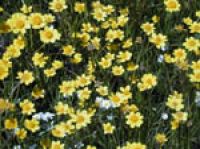
Lasthenia conjugens, commonly known as Contra Costa goldfields, is an endangered species of wildflower endemic to a limited range within the San Francisco Bay Area of the state of California, USA. Specifically this rare species occurs in Napa, Santa Barbara, Solano, Contra Costa, Santa Clara, Monterey and Alameda Counties. This annual herb typically flowers from March through June, and its colonies grow in vernal pool habitats at elevations not exceeding 100 meters above sea level. The Jepson Manual notes that the present distribution is limited to the deltaic Sacramento Valley, principally Napa and Solano Counties, but the historic range of L. conjugens is known to be significantly wider. In any case, historically the range has included parts of the North Coast, Sacramento Valley, and San Francisco Bay Area as well as the South Coast. Alternatively and less frequently this taxon has been referred to as Baeria fremontii var. conjugens.
The midvalley fairy shrimp, Branchinecta mesovallensis, is a small freshwater crustacean in the Branchinectidae family endemic to shallow ephemeral pools near the middle of California's Central Valley. These vernal pool ecosystems are home to other unique organisms adapted to the ephemeral nature of the water cycle in the pools in California's mediterranean climate.
Hesperevax caulescens is a small flowering plant in the daisy family. One common name for the plant is hogwallow starfish, as it is a somewhat flat, star-shaped plant which grows in mud. Another common name is dwarf dwarf-cudweed, as the three members of genus Hesperevax are known as dwarf-cudweeds and this species is smaller than the others. It may also be called involucrate evax, since its former Latin name was Evax involucrata. This annual plant is a member of the vernal pool plant community in California, where it is possibly an endemic species, although its range might extend into Baja California. The hogwallow starfish radiates pale green spoon-shaped leaves in a basal rosette and extends a short erect stem. The flowers are less than two millimeters wide. This species grows along the outskirts of vernal pools in areas which have dried.

Eryngium aristulatum, known by the common names California eryngo and Jepson's button celery, is a species of flowering plant in the family Apiaceae.
Eryngium constancei is a species of flowering plant in the family Apiaceae known by the common name Loch Lomond button celery, or Loch Lomond coyote thistle. It is endemic to California, where it is known from only three occurrences north of the San Francisco Bay Area. One of the populations is at the Loch Lomond Vernal Pool Ecological Reserve at Loch Lomond in Lake County. The plant appears mainly in vernal pools. It is endangered on the state and federal levels.

The Loch Lomond Vernal Pool Ecological Reserve is a nature reserve of 8.22 acres (33,300 m2) in the community of Loch Lomond in Lake County, California. It is one of 119 ecological reserves managed by the California Department of Fish and Game (CDFG). The ecological reserve system was authorized by the state legislature in 1968 for the purpose of conservation and protection of rare plants, animals and habitats.

The Boggs Lake Ecological Reserve is a nature reserve in Lake County, California. The land area is about one quarter of a square mile and contains a large vernal pool as well as endangered plants such as the Boggs Lake hedge-hyssop.

Euphorbia melanadenia is a species of Euphorbia known by the common name red-gland spurge. It is native to the deserts and mountains of Baja California and southern California and Arizona, where it grows in dry, rocky habitat. It is a perennial herb forming a small clump or mat of very slender, tangling red stems. The stems are lined with pairs of slightly woolly oval-shaped leaves 2 to 9 millimeters wide. The tiny inflorescence is a cyathium less than 2 millimeters wide. The cyathium is a bell-shaped array of white, scalloped petal-like appendages surrounding the actual flowers. Each appendage has at its base a shiny red nectar gland. At the center of the appendages is a ring of male staminate flowers around a single female flower. The female flower develops into an oval-shaped fruit which bears wrinkled white seeds.
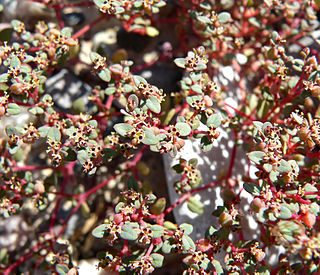
Euphorbia micromera is a species of flowering plant in the family Euphorbiaceae. It is known by the common name Sonoran sandmat. It is native to the southwestern United States from California to Texas, and northern Mexico, where it grows in sandy soils in desert and other dry habitat. It is an annual herb forming a small mat of slender stems. The hairy to hairless leaves are oblong in shape and just a few millimeters long. The tiny inflorescence is a cyathium less than a millimeter wide. It lacks the appendages that many similar species have in their cyathia. It has only a central female flower and 2 to 5 male flowers surrounded by round red nectar glands. The fruit is a minute round capsule.
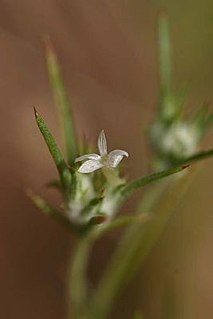
Eriastrum hooveri is a rare species of flowering plant in the phlox family known by the common name Hoover's woollystar. It is endemic to the South Coast Ranges of California from San Benito to Los Angeles Counties, where it grows in grassy open habitat. It is an annual herb producing a wiry, usually woolly stem up to about 15 centimeters tall. The leaves are linear and threadlike, less than three centimeters long, and sometimes divided into two thready lobes. The inflorescence is a woolly cluster of narrow, leaflike bracts laced with webby fibers. The flowers are white and just a few millimeters in length.

Orcuttia is a genus of grass in the family Poaceae. Plants grow up to 20 cm (8 in) tall, usually with many stems emerging from the base of the plant, and forming a tuft. The spikelets are several-flowered, with reduced upper florets. The lemma tips have between two and five teeth.
Minuartia californica, commonly known as California sandwort, is a species of flowering plant in the family Caryophyllaceae.

Navarretia fossalis is a rare species of flowering plant in the phlox family known by the common name spreading navarretia.
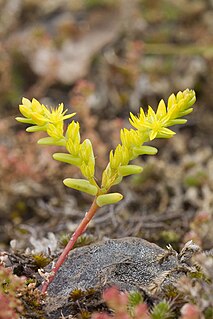
Sedella pumila is a species of flowering plant in the family Crassulaceae known by the common name Sierra mock stonecrop. It is native to California, where it grows in the North Coast Ranges and adjacent sections of the Central Valley to the Sierra Nevada foothills. It is a plant of vernal pools and similar habitat, growing in rocky and gravelly flats of serpentine soils, limestone, and soils of volcanic origin, often alongside mosses. This is an annual herb growing 2 to 17 centimeters high, in shades of green, yellow, and red. It has small knobby succulent leaves each a few millimeters long. The flowers atop the threadlike stems have fleshy sepals and yellowish petals a few millimeters in length. The flowers have a musty scent.

Gratiola amphiantha is a rare species of flowering plant known by the common names little amphianthus, pool sprite and snorkelwort. It was previously the only species in the monotypic genus Amphianthus, but it was moved to genus Gratiola after genetic analysis in 2008. It is native to the Piedmont region of the southeastern United States, with a center of distribution in Georgia. It occurs in Alabama and South Carolina as well. It is limited to granite outcrops, a high-biodiversity habitat type that is threatened by activities such as quarrying, off-road vehicles, and trash and debris dumping. It is a federally listed threatened species.
Euphorbia eleanoriae is a rare species of flowering plant in the euphorb family known by the common name Nā Pali sandmat. It is endemic to Kauaʻi, Hawaii. Like other native Hawaiian euphorbs it is called ʻakoko locally. This plant was only discovered in 1992 and described to science in 1996 as Chamaesyce eleanoriae. At that time there were fewer than 500 plants known, all occurring in small populations scattered across the sheer cliffs along the Nā Pali Coast of Kauaʻi. By 2001 the total population had already dropped; only three populations were found, for a total of fewer than 50 plants. The plant was federally listed as an endangered species of the United States in 2010.
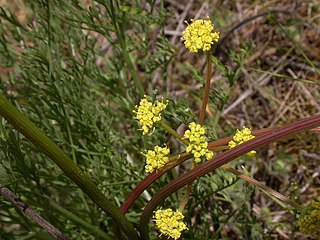
Lomatium cookii is a rare species of flowering plant in the carrot family known by the common names Cook's lomatium and agate desertparsley. It is endemic to Oregon in the United States, where it grows in only two valleys. It is a federally listed endangered species.

Euphorbia missurica, commonly called prairie sandmat, or Missouri spurge, is a species of flowering plant in the spurge family (Euphorbiaceae). It is native to North America, where it is found primarily in area of the Great Plains. Its natural habitat is in dry, often calcareous areas, including glades, bluffs, and open woodlands.















